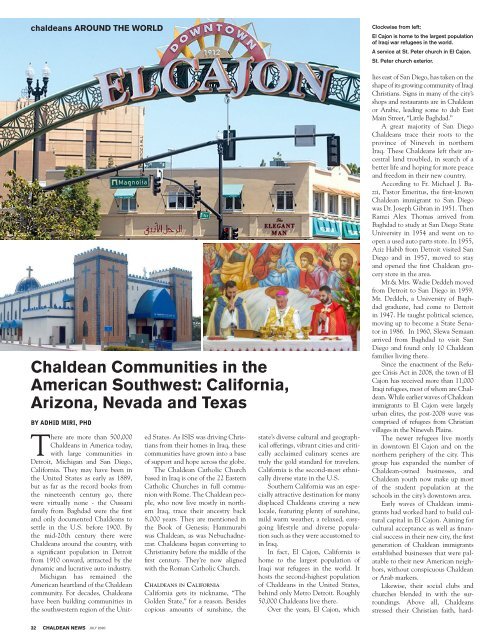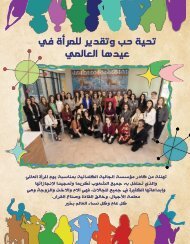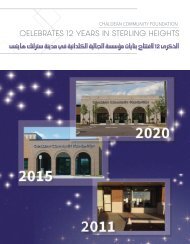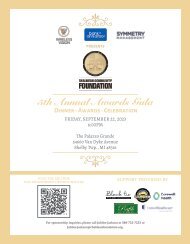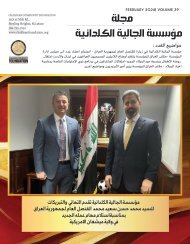Create successful ePaper yourself
Turn your PDF publications into a flip-book with our unique Google optimized e-Paper software.
chaldeans AROUND THE WORLD<br />
Chaldean Communities in the<br />
American Southwest: California,<br />
Arizona, Nevada and Texas<br />
BY ADHID MIRI, PHD<br />
PHOTO BY SEYOZ 4 ALL<br />
There are more than 500,000<br />
Chaldeans in America today,<br />
with large communities in<br />
Detroit, Michigan and San Diego,<br />
California. They may have been in<br />
the United States as early as 1889,<br />
but as far as the record books from<br />
the nineteenth century go, there<br />
were virtually none - the Oussani<br />
family from Baghdad were the first<br />
and only documented Chaldeans to<br />
settle in the U.S. before 1900. By<br />
the mid-20th century there were<br />
Chaldeans around the country, with<br />
a significant population in Detroit<br />
from 1910 onward, attracted by the<br />
dynamic and lucrative auto industry.<br />
Michigan has remained the<br />
American heartland of the Chaldean<br />
community. For decades, Chaldeans<br />
have been building communities in<br />
the southwestern region of the United<br />
States. As ISIS was driving Christians<br />
from their homes in Iraq, these<br />
communities have grown into a base<br />
of support and hope across the globe.<br />
The Chaldean Catholic Church<br />
based in Iraq is one of the 22 Eastern<br />
Catholic Churches in full communion<br />
with Rome. The Chaldean people,<br />
who now live mostly in northern<br />
Iraq, trace their ancestry back<br />
8,000 years. They are mentioned in<br />
the Book of Genesis; Hammurabi<br />
was Chaldean, as was Nebuchadnezzar.<br />
Chaldeans began converting to<br />
Christianity before the middle of the<br />
first century. They’re now aligned<br />
with the Roman Catholic Church.<br />
Chaldeans in California<br />
California gets its nickname, “The<br />
Golden State,” for a reason. Besides<br />
copious amounts of sunshine, the<br />
state’s diverse cultural and geographical<br />
offerings, vibrant cities and critically<br />
acclaimed culinary scenes are<br />
truly the gold standard for travelers.<br />
California is the second-most ethnically<br />
diverse state in the U.S.<br />
Southern California was an especially<br />
attractive destination for many<br />
displaced Chaldeans craving a new<br />
locale, featuring plenty of sunshine,<br />
mild warm weather, a relaxed, easygoing<br />
lifestyle and diverse population<br />
such as they were accustomed to<br />
in Iraq.<br />
In fact, El Cajon, California is<br />
home to the largest population of<br />
Iraqi war refugees in the world. It<br />
hosts the second-highest population<br />
of Chaldeans in the United States,<br />
behind only Metro Detroit. Roughly<br />
50,000 Chaldeans live there.<br />
Over the years, El Cajon, which<br />
Clockwise from left:<br />
El Cajon is home to the largest population<br />
of Iraqi war refugees in the world.<br />
A service at St. Peter church in El Cajon.<br />
St. Peter church exterior.<br />
lies east of San Diego, has taken on the<br />
shape of its growing community of Iraqi<br />
Christians. Signs in many of the city’s<br />
shops and restaurants are in Chaldean<br />
or Arabic, leading some to dub East<br />
Main Street, “Little Baghdad.”<br />
A great majority of San Diego<br />
Chaldeans trace their roots to the<br />
province of Nineveh in northern<br />
Iraq. These Chaldeans left their ancestral<br />
land troubled, in search of a<br />
better life and hoping for more peace<br />
and freedom in their new country.<br />
According to Fr. Michael J. Bazzi,<br />
Pastor Emeritus, the first-known<br />
Chaldean immigrant to San Diego<br />
was Dr. Joseph Gibran in 1951. Then<br />
Ramzi Alex Thomas arrived from<br />
Baghdad to study at San Diego State<br />
University in 1954 and went on to<br />
open a used auto parts store. In 1955,<br />
Aziz Habib from Detroit visited San<br />
Diego and in 1957, moved to stay<br />
and opened the first Chaldean grocery<br />
store in the area.<br />
Mr.& Mrs. Wadie Deddeh moved<br />
from Detroit to San Diego in 1959.<br />
Mr. Deddeh, a University of Baghdad<br />
graduate, had come to Detroit<br />
in 1947. He taught political science,<br />
moving up to become a State Senator<br />
in 1986. In 1960, Slewa Semaan<br />
arrived from Baghdad to visit San<br />
Diego and found only 10 Chaldean<br />
families living there.<br />
Since the enactment of the Refugee<br />
Crisis Act in 2008, the town of El<br />
Cajon has received more than 11,000<br />
Iraqi refugees, most of whom are Chaldean.<br />
While earlier waves of Chaldean<br />
immigrants to El Cajon were largely<br />
urban elites, the post-2008 wave was<br />
comprised of refugees from Christian<br />
villages in the Nineveh Plains.<br />
The newer refugees live mostly<br />
in downtown El Cajon and on the<br />
northern periphery of the city. This<br />
group has expanded the number of<br />
Chaldean-owned businesses, and<br />
Chaldean youth now make up most<br />
of the student population at the<br />
schools in the city’s downtown area.<br />
Early waves of Chaldean immigrants<br />
had worked hard to build cultural<br />
capital in El Cajon. Aiming for<br />
cultural acceptance as well as financial<br />
success in their new city, the first<br />
generation of Chaldean immigrants<br />
established businesses that were palatable<br />
to their new American neighbors,<br />
without conspicuous Chaldean<br />
or Arab markers.<br />
Likewise, their social clubs and<br />
churches blended in with the surroundings.<br />
Above all, Chaldeans<br />
stressed their Christian faith, hard-<br />
32 CHALDEAN NEWS <strong>JULY</strong> <strong>2020</strong>


